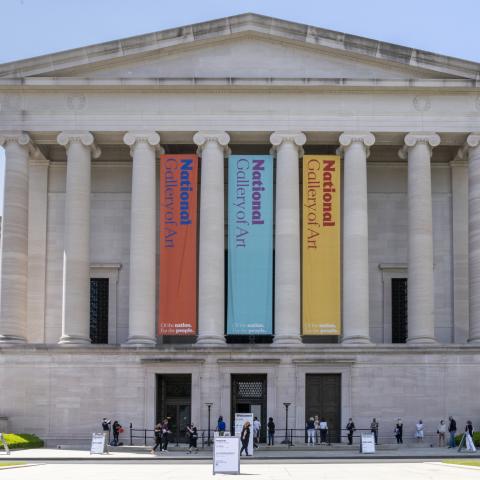Madonna and Child Enthroned
c. 1420
Gentile da Fabriano
Artist, Marchigian, c. 1370 - 1427

Gentile da Fabriano's patrons were princes, the church, and various city governments as well as the customary merchant clients. His art has a cosmopolitan flavor, in which brilliant color, textural richness, and ornamental pattern are combined.
In the Madonna and Child Enthroned, painted in Florence, Mary sits on a bench covered by floral material that falls onto an elaborately tiled floor. The elegantly attired figures are surrounded by four angels, barely visible, which have been incised into the gold-leaf background. In contrast to earlier devotional images in which the Madonna and Child appear as a celestial vision, the holy figures here appear very corporeal. As if to emphasize Mary's role as Divine Mother, the Christ Child gestures with his right hand toward the Latin word Mater inscribed on the collar of her mantle. The string in his other hand tethers a butterfly, a traditional symbol of Christ's resurrection from the tomb.
Gentile's art is typical of the International Style, a manner of painting which became popular at courts throughout Europe in the late fourteenth and early fifteenth centuries. Characterized by a refined decorative elegance, a concern for continuous rhythms, and the lavish use of gold and bright colors, this aristocratic manner fused the stylized art of the Middle Ages with the emerging naturalistic interests of the Renaissance.

West Building Main Floor, Gallery 3
Artwork overview
-
Medium
tempera on poplar panel
-
Credit Line
-
Dimensions
overall: 95.7 x 56.5 cm (37 11/16 x 22 1/4 in.)
framed: 108.6 x 64.8 x 8.9 cm (42 3/4 x 25 1/2 x 3 1/2 in.) -
Accession Number
1939.1.255
Artwork history & notes
Provenance
Alexander Barker [c. 1797-1873], London, who possibly acquired it in Florence;[1] (his sale, Christie, Manson & Woods, London, 6 June 1874, no. 45); (Grüner). E.J. Sartoris, London(?), and Paris, by 1876;[2] (Nathan Wildenstein and René Gimpel, Paris and New York), by 1913;[3] purchased 1918 by Henry Goldman [1856-1937], New York;[4] (Duveen Brothers, Inc., London and New York);[5] sold March 1937 to the Samuel H. Kress Foundation, New York;[6] gift 1939 to NGA.
[1] On Barker as a collector see Gustav Friedrich Waagen, Treasures of Art in Great Britain, 3 vols., London, 1854: 2:125-129, and Galleries and Cabinets of Art in Great Britain, London, 1857: 71-79; George Redford, Art Sales: A History of Sales of Pictures and Other Works of Art, 2 vols., London, 1888: 1:194; and John Fleming, "Art Dealing in the Risorgimento-II," The Burlington Magazine 121 (1979): 505-506. Barker frequently visited Florence and apparently knew both the city and its art market very well; it is likely therefore that he acquired the panel in this city, perhaps (since Waagen fails to cite the painting in his collection), after 1857.
A fact that apparently challenges this work's provenance from the Barker collection is that the description given in the sale catalogue of 1874 ("The Madonna with the Infant Savior seated upon her lap holding a pomegranate") does not correspond with the appearance of this painting. There is some chance that the pomegranate was the result of a restorer's effort to reconstruct the object held by the Child and that it was cleaned away sometime between 1874 and 1911, and it cannot be excluded that the description was inaccurate. In fact, it is difficult to see why the Barker provenance should have been "invented" as early as 1922, in Valentiner's entry for the catalogue of the Goldman collection.
[2] In an entry dated 7 July 1918, made shortly after the sale of the painting to Henry Goldman, the dealer René Gimpel wrote in his diary that the painting "avait appartenu à un canadien anglais, Mr. Sartis [sic], qui, était venu se fixer à Paris, l'avait prêté au Musée des Arts Décoratifs" ("had belonged to an English Canadian, Mr. Sartis, who, having settled in Paris, had lent it to the Musée des Arts Decoratifs") (see René Gimpel, Journal d'un collectionneur, marchandde tableaux, Paris, 1963; English ed., Diary of an Art Dealer, New York, 1966). One can presume that the collector was living in London around 1876, when he lent the painting to the exhibition of the Royal Academy there. It is not known how long the painting hung in the Musée des Arts Decoratifs in Paris, but since Colasanti was able to publish it in the first issue of Bollettino d'Arte for the year 1911, it was certainly there at least by 1910. And in fact Gimpel 1963: 55, who probably acquired the painting in 1912, wrote that "il etait resté longtemps exposé" in the museum.
[3] See Everett Fahy, "Review of Fern Rusk Shapley, Paintings from the Samuel H. Kress Collection: Italian Schools, XV-XVI Century," Art Bulletin 56, no. 2 (June 1974): 283. The photograph of the painting in the Biblioteca Berenson at I Tatti near Florence bears the stamp "Wildenstein-Gimpel, New York." A letter from Bernard Berenson dated 14 January 1913 to René Gimpel (copy in NGA curatorial files) proves that at this date, and very probably already by the end of the preceding year, the painting was in Gimpel's possession.
[4] Fahy 1974: 283 gives the date of the sale to Henry Goldman as "before July 1, 1918."
[5] See Duveen Pictures in Public Collections of America, New York, 1941: no. 26.
[6] The Duveen Brothers letter confirming the sale twenty-four paintings, including NGA 1939.1.255, is dated 9 March 1937; the provenance is given as "Henry Goldman Collection" (copy in NGA curatorial files; Box 474, Folder 5, Duveen Brothers Records, accession number 960015, Research Library, Getty Research Institute, Los Angeles). See also The Kress Collection Digital Archive, https://kress.nga.gov/Detail/objects/1348.
Associated Names
Exhibition History
1876
Exhibition of Works by the Old Masters. Winter Exhibition, Royal Academy of Arts, London, 1876, no. 195, as The Virgin and Child.
1910
Loan for display with permanent collection, Musée des Arts Décoratifs, Paris, at least 1910-1911.
1920
Fiftieth Anniversary Exhibition, The Metropolitan Museum of Art, New York, 1920, unnumbered catalogue.
Bibliography
1941
Preliminary Catalogue of Paintings and Sculpture. National Gallery of Art, Washington, 1941: 74, no. 366.
Duveen Brothers. Duveen Pictures in Public Collections of America. New York, 1941: no. 26, repro.
1942
Book of Illustrations. National Gallery of Art, Washington, 1942: 247, repro. 110.
1944
Cairns, Huntington, and John Walker, eds. Masterpieces of Painting from the National Gallery of Art. New York, 1944: 26, color repro.
Frankfurter, Alfred M. The Kress Collection in the National Gallery. New York, 1944: 74, repro. no. 49
1945
Paintings and Sculpture from the Kress Collection. National Gallery of Art, Washington, 1945 (reprinted 1947, 1949): 23, repro.
1951
Einstein, Lewis. Looking at Italian Pictures in the National Gallery of Art. Washington, 1951: 30, repro. 28.
1957
Shapley, Fern Rusk. Comparisons in Art: A Companion to the National Gallery of Art, Washington, DC. London, 1957 (reprinted 1959): pl. 4.
1959
Paintings and Sculpture from the Samuel H. Kress Collection. National Gallery of Art, Washington, 1959: 46, repro.
Shapley, Fern Rusk. Early Italian Painting in the National Gallery of Art. Washington, D.C., 1959 (Booklet Number Three in Ten Schools of Painting in the National Gallery of Art, Washington, D.C.): 22, color repro.
1961
Walker, John, Guy Emerson, and Charles Seymour. Art Treasures for America: An Anthology of Paintings & Sculpture in the Samuel H. Kress Collection. London, 1961: 9-12, color repro.
1963
Walker, John. National Gallery of Art, Washington, D.C. New York, 1963 (reprinted 1964 in French, German, and Spanish): 298, repro.
1965
Summary Catalogue of European Paintings and Sculpture. National Gallery of Art, Washington, 1965: 56.
1966
Shapley, Fern Rusk. Paintings from the Samuel H. Kress Collection: Italian Schools, XIII-XV Century. London, 1966: 76-77, fig. 212.
Cairns, Huntington, and John Walker, eds. A Pageant of Painting from the National Gallery of Art. 2 vols. New York, 1966: 1:10, color repro.
1968
National Gallery of Art. European Paintings and Sculpture, Illustrations. Washington, 1968: 48, repro.
Berenson, Bernard. Italian Pictures of the Renaissance: Central and North Italian Schools, 3 vols. London, 1968: 1:165.
1973
Finley, David Edward. A Standard of Excellence: Andrew W. Mellon Founds the National Gallery of Art at Washington. Washington, 1973: 79.
1975
European Paintings: An Illustrated Summary Catalogue. National Gallery of Art, Washington, 1975: 148, repro.
1979
Shapley, Fern Rusk. Catalogue of the Italian Paintings. 2 vols. National Gallery of Art, Washington, 1979: 1:195-196; 2:pl. 136.
1982
Christiansen, Keith. Gentile da Fabriano. London, 1982: 21, 37, 92-93, pls. 18, 19.
1985
European Paintings: An Illustrated Catalogue. National Gallery of Art, Washington, 1985: 171, repro.
1991
Kopper, Philip. America's National Gallery of Art: A Gift to the Nation. New York, 1991: 178, color repro.
1992
National Gallery of Art. National Gallery of Art, Washington. New York, 1992: 13, repro.
De Marchi, Andrea. Gentile da Fabriano: Un viaggio nella pittura italiana alla fine del gotico. Milan, 1992: 169, 172, pl. 57.
1993
Gagliardi, Jacques. La conquête de la peinture: L’Europe des ateliers du XIIIe au XVe siècle. Paris, 1993: 257.
2003
Boskovits, Miklós, and David Alan Brown, et al. Italian Paintings of the Fifteenth Century. The Systematic Catalogue of the National Gallery of Art. Washington, D.C., 2003: 288-292, color repro.
2004
Hand, John Oliver. National Gallery of Art: Master Paintings from the Collection. Washington and New York, 2004: 18, no. 10, color repro.
Inscriptions
upper center on the Virgin's collar: MATER (Mother) [DEI]; across bottom on the hem of her dress: AVE MARIA GRATIA PLENA DOM[INVS] TECV[M] BEN[EDICTA] (Hail, Mary, full of grace, the Lord is with thee, blessed), from Luke 1:28
Wikidata ID
Q3842477

